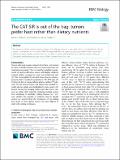| dc.contributor.author | Abbott, Keene L. | |
| dc.contributor.author | Vander Heiden, Matthew G. | |
| dc.date.accessioned | 2021-12-02T15:01:32Z | |
| dc.date.available | 2021-11-01T14:33:30Z | |
| dc.date.available | 2021-12-02T15:01:32Z | |
| dc.date.issued | 2021-05-10 | |
| dc.identifier.uri | https://hdl.handle.net/1721.1/136805.2 | |
| dc.description.abstract | Abstract
The extent to which tumors acquire nutrients from dietary sources as opposed to from the breakdown of host tissues is not known. In this issue of BMC Biology, Holland et al. report an approach where food sources with different isotope labeled carbon ratios can be used to answer this question, and find that tumors arising in Drosophila melanogaster procure most of their nutrients from the host. | en_US |
| dc.description.sponsorship | NSF (Grants GRFP DGE-1122374 and T32GM007287) | en_US |
| dc.description.sponsorship | NIH (Grants R35CA242379, R01CA201276, P30CA14051) | en_US |
| dc.publisher | BioMed Central | en_US |
| dc.relation.isversionof | https://doi.org/10.1186/s12915-021-01027-y | en_US |
| dc.rights | Creative Commons Attribution | en_US |
| dc.rights.uri | https://creativecommons.org/licenses/by/4.0/ | en_US |
| dc.source | BioMed Central | en_US |
| dc.title | The CAT-SIR is out of the bag: tumors prefer host rather than dietary nutrients | en_US |
| dc.type | Article | en_US |
| dc.identifier.citation | BMC Biology. 2021 May 10;19(1):92 | en_US |
| dc.contributor.department | Koch Institute for Integrative Cancer Research at MIT | en_US |
| dc.eprint.version | Final published version | en_US |
| dc.type.uri | http://purl.org/eprint/type/JournalArticle | en_US |
| eprint.status | http://purl.org/eprint/status/PeerReviewed | en_US |
| dc.date.updated | 2021-05-16T03:11:46Z | |
| dc.language.rfc3066 | en | |
| dc.rights.holder | The Author(s) | |
| dspace.date.submission | 2021-05-16T03:11:46Z | |
| mit.license | PUBLISHER_CC | |
| mit.metadata.status | Publication Information Needed | en_US |
